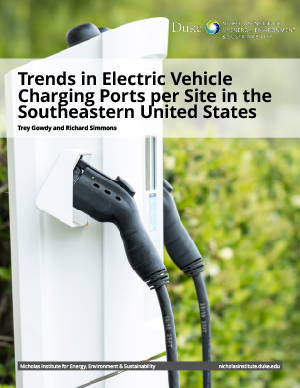Q&A with Trey Gowdy: Trends in Electric Vehicle Charging Ports in the Southeast

As the electric vehicle (EV) market expands in the United States, the public and private sectors are rapidly investing in charging infrastructure to keep those vehicles on the road. One model identifies the need for 26 million to 35 million publicly accessible charging ports by 2030.
Like the United States as a whole, the Southeast is rapidly deploying direct current (DC) fast charging stations along highway corridors and Level 2 stations within communities for gradual charging. A new report published by Duke University’s Nicholas Institute for Energy, Environment & Sustainability examines trends in EV charging ports per station across 12 Southeastern states. The report was co-authored by the facilitators of the Southeast Electric Transportation Regional Initiative (SETRI): Trey Gowdy, a research analyst at the Nicholas Institute, and Richard Simmons, director of research and studies at the Georgia Tech Strategic Energy Institute.
Gowdy reflected on the report’s findings and how decision-makers could apply them to further build out EV infrastructure in the Southeast region.
Q: What is the importance of measuring the number of ports per station in addition to just the number of stations themselves?
There are two key reasons for this. First, we wanted to see current market practices across the region in relation to minimum standards of the National Electric Vehicle Infrastructure (NEVI) program, a multi-billion-dollar federal program that requires four ports per DC fast charging station along highway corridors. Second, we sought to understand broad trends for how both Level 2 and DC fast charging stations have changed over a decade of growth in charging infrastructure across region—essentially, have stations gotten smaller or larger over time?
Q: What are the implications of your findings for future charging sites in the Southeast?
While Level 2 stations have been consistent in the number of ports over time, the DC fast charging space is much more complex. The average is over four ports per station, but that does not tell the full story. About 40 percent of fast charging stations in the region have one port. And then there are a growing number of stations with upwards of eight, twelve or more ports. The key takeaway is the DC fast charging space has a lot of variety in station sizes, which will be important to keep in mind for station reliability, capacity and use cases as EV infrastructure is further built out.
Q: How can public agencies and private enterprises use the data you have analyzed to better serve the transportation electrification market?
This analysis can help establish a common practice for EV charging station ports and set boundaries for how a station or set of stations being considered, designed or built fits within current regional trends. It’s our aim that these data points will provide context around current regional EV infrastructure and contribute to complex decisions around effective public and private investments in future charging infrastructure.
Q: How do you see your findings fitting into ongoing and future research?
When we examine charging ports per station, we’re looking at just one aspect of EV infrastructure. We believe these findings can help advance discussion around charging stations having sufficient redundancy, where applicable, for reliability. They could also be useful in setting a regional baseline as the NEVI program is implemented over the next 4–5 years. Ultimately, we hope our research contributes to future work around the quality and equitable deployment of public EV charging stations.
About the Southeast Electric Transportation Regional Initiative
SETRI—a multisector network of businesses, manufacturers, nonprofit organizations, research institutions and more—seeks to convene, collaborate with and inform stakeholders in transportation electrification across the Southeast. Duke’s Nicholas Institute for Energy, Environment & Sustainability and the Georgia Tech Strategic Energy Institute facilitate SETRI in collaboration with additional partner organizations. Read more about SETRI at southeastev.org.
# # #
CITATION: Gowdy, T., and R. Simmons. 2023. Trends in Electric Vehicle Charging Ports per Site in the Southeastern United States. NI R 23-06. Durham, NC: Duke University. https://nicholasinstitute.duke.edu/publications/trends-electric-vehicle-charging-ports-site-southeastern-us.
Research for the report was supported by funding from Energy Foundation.




